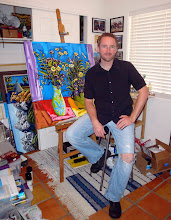
This week the easel is empty. I decided a few days ago to make my last painting, a blooming Agave, the last painting of 2007. (The image to the left is 'Saguaro at Romero Ruins' finished a couple of weeks ago). It seemed appropriate as I thought about Agaves, how they raise their central shoots as high as they possibly can and then bloom - casting their seeds to the earth before the Agave dies. Painters like myself, we do the same. We work sowing the seeds of our paintings in the world - then they go into the world and the images take own their own lives. It makes me think of that wonderful feeling you get in high-quality art galleries, that feeling of assurance that you are not alone. That you are there with the shadows of all those artists who came before you.
I find myself thinking of the Counting Crows song "Long December" that goes "It's been a long December and there's reason to believe, maybe this year will be better than the last..."
For me, 2007 was a very good year. If I am honest with myself, I should say that it was a year like many others - one which was beset with challenges and problems of it's own sort, but not such as would diminish the accomplishments of the year. In February my work was featured in Tucson Home Magazine as part of their "3 of a Kind" artist series. And in November I was featured in the "Best of the West" section in Southwest Art Magazine. It has been a godsend that magazines have written about my work, and it is my goal to continue to give them something in my paintings that will keep them thinking and keep those keyboards clicking. And as always, sales have been good and steady in 2007 - even during the slow Summers here in Arizona.
If there has been a change in my work this past year, I could probably say that the overall texture of the paintings has become thicker, creating a more abrasive surface. This has been useful in implying movement, even in the sky which is usually far away in many artist's works. I've also explored other regions, resulting in paintings of Acoma Pueblo as well as farther afield at Easter Island, and the Baobabs of Madagascar. I still see, in my mind's eye, paintings of Washington DC, of France, and new images from New Zealand. I've yet to know how they are going to materialize. They may emerge in 2008.
There is no grand wisdom to ponder when a year comes to a close - only the simple thought, the sense that time is passing. A few more lines around the eyes, a few more aches where you never had aches before...and the creeping sensation that there is no time to waste in our lives. That if we believe we are here for a purpose, it is our job to do that thing, to give it life and meaning. So that when we are older and look back on our limited time in this world, we can say to ourselves "I did it."
We are all given to one another for a time, and just as that time had a beginning, it will also have an end. So don't waste one more minute in this world - tell people how you feel, be as honest as good society will let you be - and have the courage to make the best of every moment.
It may have been a "Long December", but yeah, there's reason to believe - maybe next year will be better than the last.
Happy 2008 to everyone!
*All images are copyright Neil Myers 2007-2008




